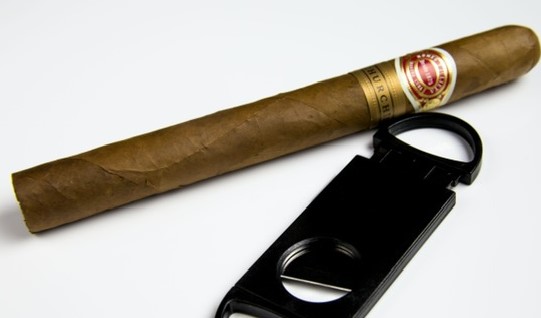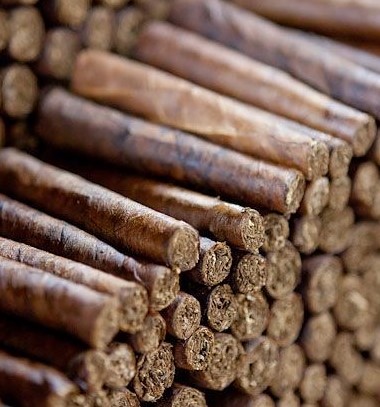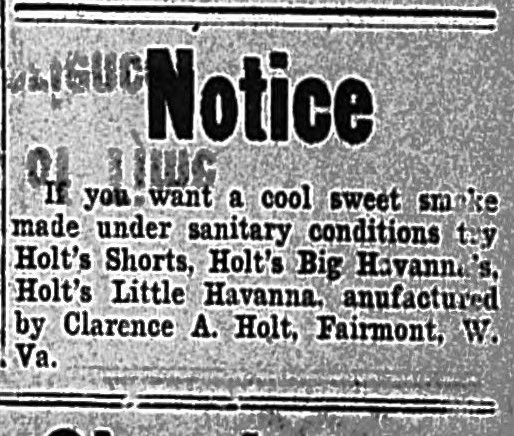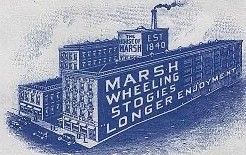

So what is a “Stogie”? It’s believed to derive from the word “stoga.” which describes a long thin cigar popular in the nineteenth century. The stogies were usually made with lower-quality tobacco leaves and often were smoked by laborers and working-class men.
Cowboys loved stogies, but sometimes instead of smoking them, they bit off a piece and chewed it.
A “Cigar,” on the other hand, is sometimes shorter and larger than a stogie. It is usually made with better tobacco, dried, and fermented to be smoked.
Both Stogies and Cigars come in various flavors and brands. My article today tells the stories of both being made in Fairmont and Mannington, West Virginia.
The cigar is something that demands respect. It is made for all the senses and all the pleasures; for the nose, the palate, the fingers, the eyes… a good cigar contains the promise of a totally pleasurable experience.
-Zano Davidoff-
Let me start by saying that I was amazed to learn that stogies and cigars were a viable business in the area. Everyone pretty much only associates Fairmont with coal. It is true that without that, as the catalyst, other companies and factories would not exist in all probability.
When I first started researching the stogie trade, I found that there were actually four companies producing stogies. They were the Fairmont Stogie Co., owned by J. S. Haggerty. They started on the corner of Diamond and Newton Street on the east side, then moved to Merchant Street on the east side. In Fairmont W. V., there is an east and west side. The Monongahela River splits it.

H. S. Gaston Co., open at 332 Jefferson Street in downtown. This company had a major fan also. Vice President Calvin Coolidge preferred “made in Fairmont” stogies from this company. It’s stated that from the time he was a lawyer in Massachusetts, about ten years ago, he has purchased Fairmont stogies. He, to this day, orders the stogies himself; he trusts no one else. Even when the First World War was going on, and women were the workforce, they produced about eight thousand stogies a day.

Clarence A. Holt was the third manufacturer of stogies in town. I could not find where they were located, only this advertisement in The Fairmont West Virginian Newspaper on January 31, 1914.
Glass Stogie Company was a company run out of the house of Samuel Glass on Maple Street, west side. From what I could ascertain, he also was a chicken farmer.
These are the four stogie manufacturers in Fairmont.
J. S. Haggerty is the man this article will deal mostly with. Haggerty Stogies have been manufactured since 1892. In 1910 Mr. Haggerty, who lived on Columbia Street east side, bought the old Diamond Street Methodist Episcopal Church and turned it into his stogie factory. The building itself no longer remains, and I could find no picture.
The stogies he made were very thin, almost the size of a pencil. He employed girls as strippers of the tobacco leaves and men as rollers.


Furthermore, at the J.S. Haggerty Co., after unions came into being, all stogies were made by hand with union workers. They were able to turn out about five hundred hand-rolled stogies a day.
The company made five different brands of stogies. That consisted of Robinson’s Best Quality, Robinson’s Eureka, Robinson’s Sumptuous, Robinson’s Big Havana, and Haggerty’s Best Stock. Most are named Robinson because Robinson was a silent partner at the time, and the brands he brought with him were established. Haggerty wanted to up his game and needed the fresh capital.
Haggerty also manufactured cigarettes, chewing and smoking tobacco to sell to retail merchants.
While on Newton Street, a larger building became available on Merchant Street, so the company moved the operation there. What was considered a great opportunity to expand became a nightmare. The company at the time was under the name of The Fairmont Stogie Company.
Meanwhile, after the move, the reason for the departure of the other business came to light. Plans had been in the works to hook the Buckhannon and Northern Railroad to downtown, and to do this; they had to level the road down to meet the East Park Avenue extension. To accomplish this, the building Haggerty had just moved into would have to be stabilized at a great cost to the company.
To realize he had been duped, Haggerty first took the city to court for wanting to trespass on his property. He demanded Fifty-thousand dollars in damages. The courts sided with the city, stating that he would have to sue the railroad for the damages. The railroad charted the path, and they would be liable.
When that court case came up in 1915, the jury could not decide who was right and stated that Fifty-Thousand dollars was an outrageous amount and declared that zero to maybe Thirty-Five thousand was a better number. It really had no bearing, though, because the case was dismissed with no agreement from the jury.
The leveling destroyed access to the building. The railroad went ahead with its plans, and Merchant, Morgantown, and Water Streets were brought into line with East Park.
This made Haggerty so upset that he sold out his side of the Fairmont Stogie Co and left the business. The company had to move, and Mrs. Virginia Dodd sold them property on Ferry St. It didn’t really help, though. The business folded a couple of years later.
Meanwhile, as all this was happening, another city was courting Haggerty to open up a cigar factory in their town. Mannington W.V., a major oil and gas well location still in Marion County, was trying to get new businesses into their vicinity. Hearing how well and how long Haggerty had been in the Tabacco business, they thought it a perfect new opportunity. Haggerty left his home on Columbia Street in Fairmont and moved to Mannington.

The Mannington Cigar Company was formed. It was located in the Koen Building just opposite the B&O Railroad Station. They occupied the second and third floors, just about Ten-Thousand square feet total. With this new venture, he bought the best tobacco and made his cigars the talk of the town. The company was doing great, and since he had so many orders, the hand rollers could not keep up. Frustrated, he decided to invent a machine that would roll the cigars faster and more uniformly than hand rollers.
In 1918 he was granted a patent for the first cigar-rolling machine. I looked this up and found that other patents were granted overseas for smaller machines that couldn’t turn out the supply as his machine could. His invention soon became the next big product for him. Stogie and cigar factories in Pennsylvania, Ohio, Virginia, New York, Havana, and London used his machines. The Mannington Board of Trade had a real feather in its cap.
While running this company, Haggerty made many trips to Scranton, Penn. and eventually opened a factory there.
Life was good. Stogies were big sellers to the working man and cigars to the middle and upper class. The stogies sold two for a nickel, and depending on the brand, a cigar might go for a dollar at the time.
Once again, Haggerty wanted a new challenge. There had been another cigar factory open up in Fairmont. Mr. C. Hutchinson, a man from a prominent family in Fairmont, launched the C. Hutchinson Cigar Factory in the old Normal School building on the corner of Quincy and Adams Street in downtown Fairmont.
He started by making stogies with 35 people, and in just 90 days, he employed over 100. Even though the company was doing well, he was not proficient in the day-to-day running of a cigar factory. He wanted to be on the business side of things. Mr. Hutchinson knew of Mr. Haggerty and his success in this business and made him an offer. If Mr. Haggerty joined his business and ran the factory for a while in time, he would merge with Haggerty’s Mannington Factory.

The C. Hutchinson Cigar Co. was using hand rollers, causing them to be behind on orders. Haggerty’s first order of business was to install 16 of his rolling machines, eventually to add 14 more, and get caught up on orders. Even when the two companies merged, they were not able to compete with another very large Cigar Factory in West Virginia. The Marsh Cigar Co. of Wheeling W.V.
It was the oldest cigar manufacturer in the United States. The stogie and cigar business in Marion County had a long and very good run, but the Marsh company was open until the doors closed in 2001. The company was bought by National Cigar and moved to Indiana.
I could not find out what happened to Mr. Haggerty. Hopefully, a relative will see this and let me know.
When you ask a person from another state what they know about West Virginia, coal is the answer. Yes, coal was and always will be the number-one product. But I’m here to inform you that we have and have had so many other valuable products that have helped us be who we are.
Cigars are a million-dollar industry. Stogies are still in the running but not as popular as in the previous era. Cigarillos are the new stogie. I’m glad we had a part in both kinds!
Thank you for taking the time to come on another journey with me into the history of Marion County W.V. If you would be so kind as to leave a comment below and tell me what you like and what I could improve on, I would appreciate it. The feedback helps.
Remember: History is the spine of America. If we do not learn and lean on it we will collapse and Fall.

Very informative! Thank you!
Thank you for taking the time to comment. I’m glad you liked the article!
Very informative and well done. Your opening comment about the significance of WV is quite poignant. The fall of tobacco and the negative impact of coal on the environment are two factors negatively affecting the long term economic outlook for the region.
First, thank you for the comment. I really feel the people of WV have no idea how much other industrial business went on in the region. I also feel we might not have fought as hard as we could to save it. All of the stories I write sort of tell that coal was not the only reason for West Virginia. Good comment!